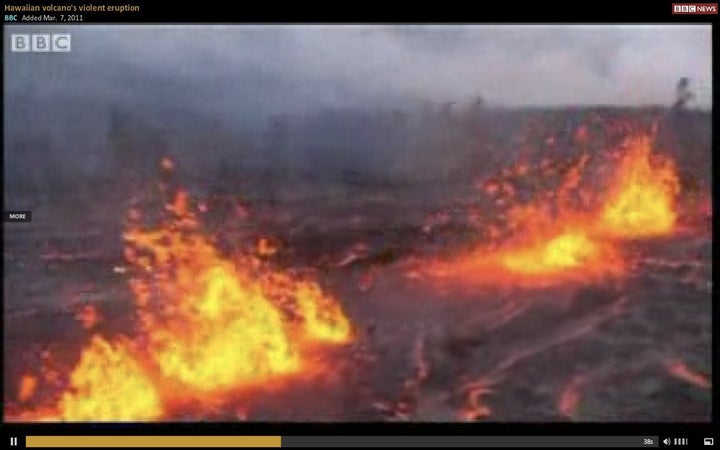
With the recent eruption of Hawaii's Kilauea, I am salivating. Not long ago, when the volcano was less active, I took a helicopter ride above it. It was thrilling, even then. But today I'm tempted to rush back to the Big Island immediately to see it in all of its majesty.
Before my copter flight, I did the typical touristy drive along Chain of Craters Road -- 18 miles of asphalt winding through Hawaii Volcanoes National Park, not far from where the famous Ironman triathlon is run. After parking the rental car, I trekked into some old lava fields, led by a guide. He explained about the different types of lava we were walking on, all cool now.
The a' a', most prevalent, is sharp and jagged; the pa-hoe-hoe, formed at hotter temperatures, is smooth, ropy and slippery, as I quickly found out, taking a spill. I was cautioned not to pocket samples of either type -- bad luck is supposed to come to those who do. Dozens of rocks are sent back to the park annually from visitors convinced that their misfortunes resulted from pilfering.
My fascination with volcanoes dates to 1989, when I climbed Mexico's 17,800-foot Popocatepetl. At the summit, when our roped team peered into the volcano's steaming crater, we could smell rank sulphurous fumes but could not see any lava. I was disappointed. Five years later Popo erupted. Today it is still active enough that climbers can no longer go to its top.
But in Hawaii I had my chance to see the red stuff. Not long after the trek, I was spiraling above the Big Island in a four-passenger Hughes 500 whirlybird. The photographer seated next to me was rigor mortis rigid. He had never been in a helicopter, let alone one whose doors have been removed to get better views.
All that separated us from the ground was a few thousand feet of tropical air and some flimsy seat belts. We had communication with one another and with the pilot, via headsets; but the photographer, chatty earlier, was silent. Drops of moisture dotted his forehead.
A few years earlier this same make of copter had encountered engine problems and crashed into an old lava flow not far from where we were, killing all aboard: three tourists and their pilot. Volcanoes are just as dangerous when approached on foot. In 1993 six volcanologists lost their lives in the crater of 14,029-foot Galeras volcano near Pasto, Colombia when it blew. In 1998 Nicaragua's Casita erupted, leaving 1,560 villagers dead.
From Hilo Airport we coptered a dozen miles, ascending steadily over tropical rain forest to Kilauea's 4,000-foot crater rim. Lush greens gave way to muted browns -- then to a charcoal-black wasteland of lava towers and steam. In the hazy distance up ahead we could make out little splotches of orange and red liquid venting from the scorched earth.
As we approached the famous Pu'u 'O'o vent, a center of activity since 1983. I asked the pilot to fly lower so I could get a better view. He balked, saying 500 feet was as low as he dared go, given the vent activity that day. Should the earth decide to really belch, a sudden updraft of hot gas could send our copter reeling. Big volcanic eruptions spew lava, gas and ash miles into the air.
The scene below was primordial. White-hot lava exited the vent, then rolled along, its thick mane darkening to shades of red and black as it cooled, as if the earth's bloodstream were clotting. The surface temperature exceeded 2,000 degrees Fahrenheit. Even from 500 feet up, it felt like an oven. Between pulses of smoke you could see the planet's heart beating, red and raw. But as quickly as the images appeared they vanished, obscured by another pulse, making you doubt you had really seen them.
On our return we crossed the slopes of 13,677-foot Mauna Loa to the Wailuku River, with its 80-foot Rainbow waterfall. The scene was peaceful, a cool contrast to the fiery chaos we'd just left. I'm thinking if I did the same flight today, that contrast would be much starker -- and even more intoxicating -- perhaps how the birth of the earth would have have looked.